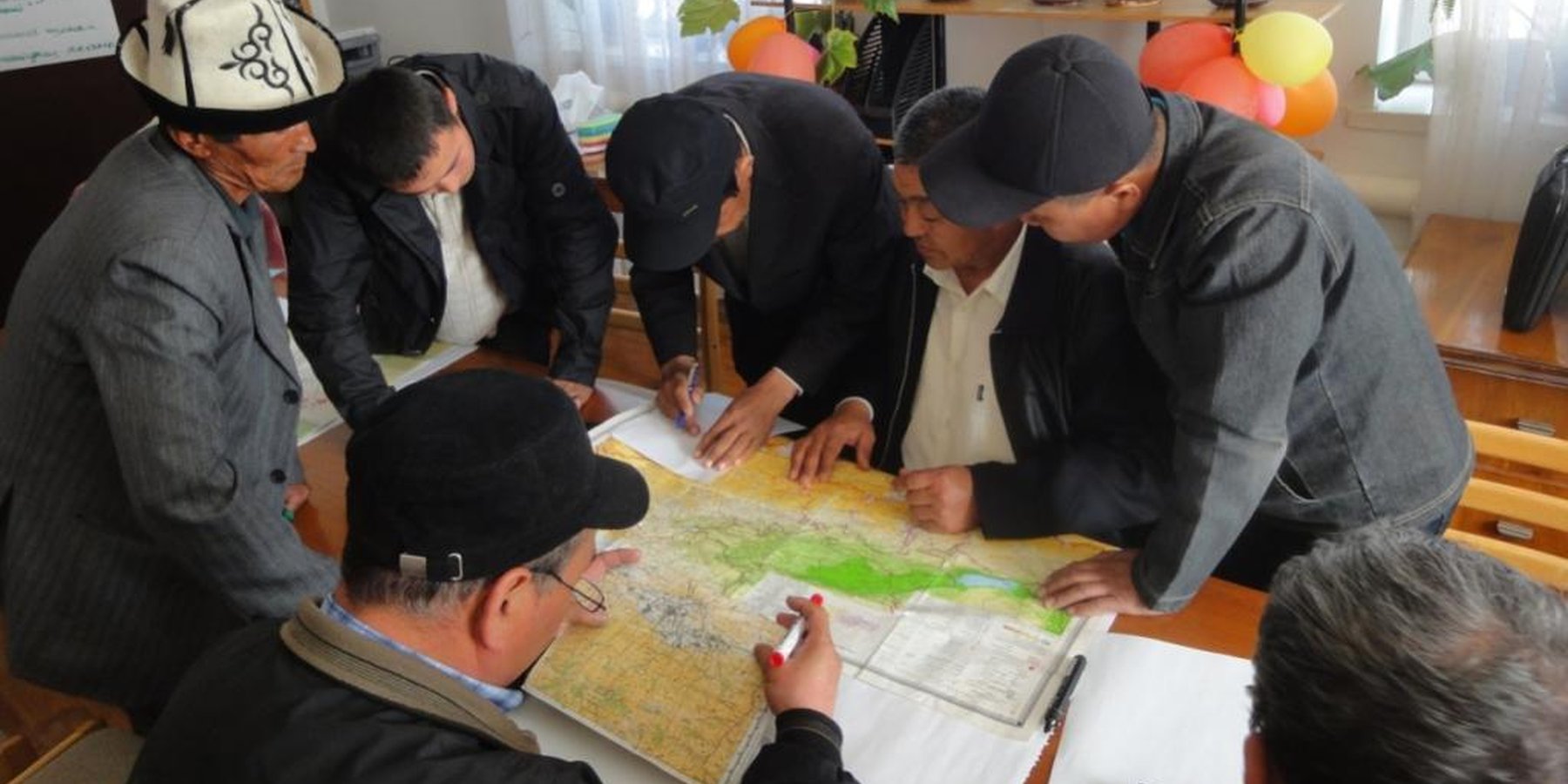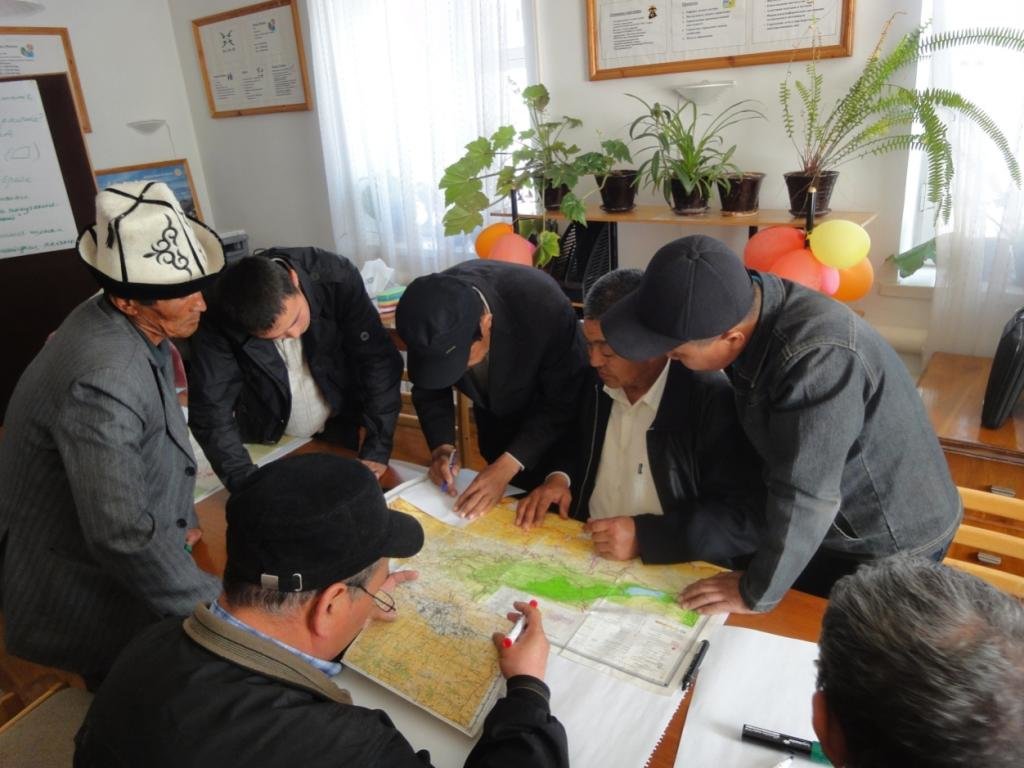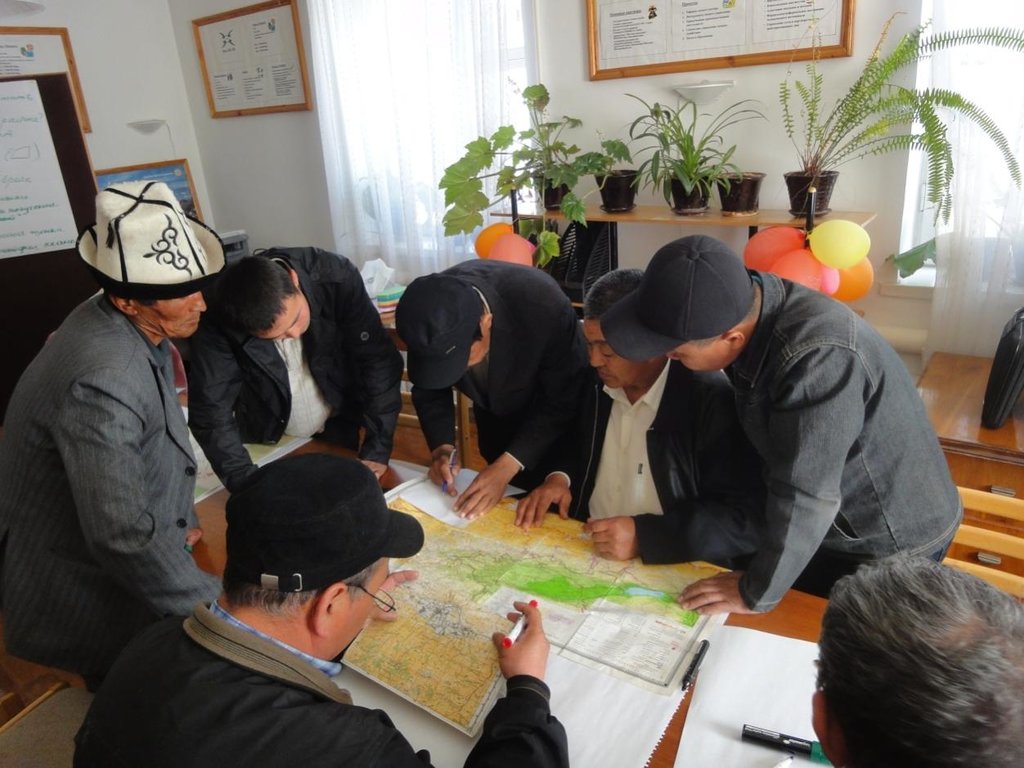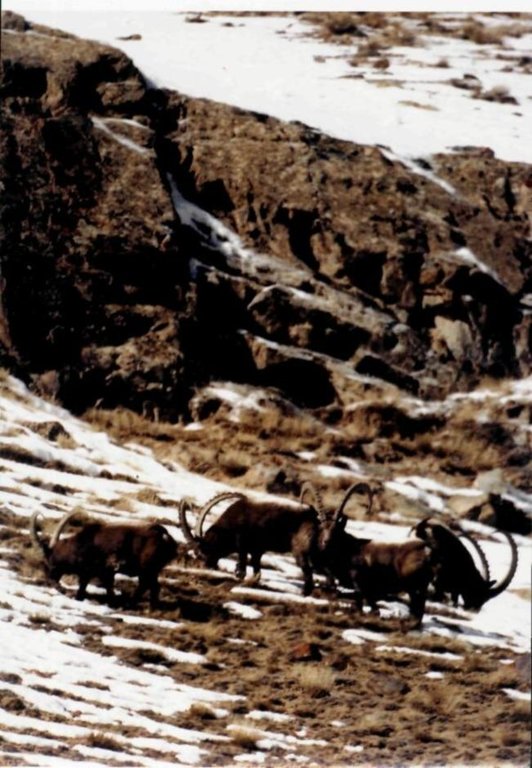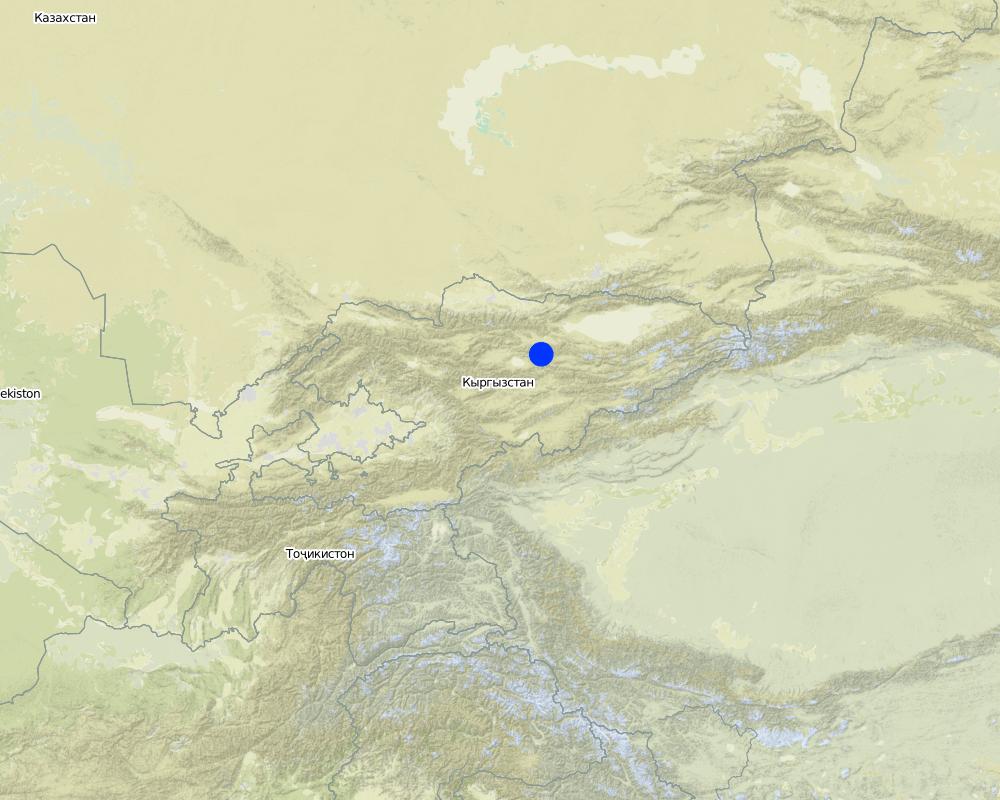Joint Wildlife Management in the mountain ecosystem of the Naryn region in Kyrgyzstan [قرغيزستان]
- تاريخ الإنشاء:
- تحديث:
- جامع المعلومات: Nazgul Esengulova
- المحرر: –
- المراجعون: Alexandra Gavilano, David Streiff
Нарын областында тоолуу экосистемаларынын табигый анчылык ресурстарын жергиликтуу жамааттардын негизинде колдонуу
approaches_2582 - قرغيزستان
عرض الأقسام
توسيع الكل طي الكل1. معلومات عامة
1.2 تفاصيل الاتصال بالأشخاص الرئيسيين لمصدر المعلومات والمؤسسات المعنية بتقييم وتوثيق النهج
متخصص في الإدارة المستدامة للأراضي:
اسم المؤسسة (المؤسسات) التي سهلت توثيق/تقييم النهج (إذا كان ذلك على صلة)
Deutsche Gesellschaft für Internationale Zusammenarbeit (GIZ) GmbH (GIZ) - ألمانيا1.3 الشروط المتعلقة باستخدام البيانات الموثقة من خلال WOCAT
متى تم تجميع البيانات (ميدانيا)؟:
11/05/2012
يوافق جامع المعلومات والشخص (لاشخاص) الرئيسي لمصدر المعلومات على الشروط المتعلقة باستخدام البيانات الموثقة من خلال WOCAT:
نعم
2. وصف نهج الإدارة المستدامة للأراضي
2.1 وصف موجز للنهج
Joint Wildlife Management based on economic empowerment and assigning hunting (wildlife) grounds to the Association of local hunters and providing her with user rights for game resources leads to a sustainable use of natural resources and biodiversity and wildlife conservation (in the frame of CACILM).
2.2 وصف تفصيلي للنهج
وصف تفصيلي للنهج:
Aims / objectives: Wildlife in Kyrgyzstan, especially mountain ungulates, is threatened because these resources can be easily accessed due to an inadequate state supervision and regulation as well as due to lack of knowledge among the local population and mechanism for integrated land use (considering different coordinated types of resource use) and resource conservation. Decrease in the natural habitat (caused by the expansion of pasture and arable land) and illegal hunting lead to a decrease in wildlife populations. In Kyrgyzstan, the fauna is exclusively owned by the state. User rights for wildlife are separated from land use ones. The approach aims at the conservation and sustainable use of wildlife based on providing representatives of the local community, organized in an Association of local hunters (ALH), with legal user rights for wildlife resources.
Methods: (1) supporting local hunters in organizing an Association of local hunters (ALH) with the help of facilitators; (2) transferring wildlife management functions from the Wildlife Department to the ALH based on assigning hunting grounds to them and providing them with user rights according to jointly developed management plans; (3) building trust in partnership relations between the ALH and the Wildlife Department of State Agency for Environmental Protection and Forestry (SAEPF) based on joint registration and monitoring and determination of the resource status (see Annex 3); (4) capacity building of the ALH with the help of independent experts and advising activities provided by the Wildlife Department; (5) developing an atmosphere of trust by establishing links between the Wildlife Department, local hunters (ALH), the local community (Aiylokmotu) and rural organizations (Pasture User Association, PUA) based on joint planning and information sharing.
Stages of implementation: (1) setting up groups of well-trained (sensitive) facilitators and training them on the principles of facilitation, conflict management and sustainable management of natural resources; (2) identifying reliable active hunters with the help of facilitators and managers by interviewing neutral people; (3) organizing a meeting at the field level to analyze the situation and identify interests in establishing of the ALH; (4) raising awareness of local hunters on wildlife resources, existing problems and possible solutions offered by sustainable management; (5) establishing an ALH in the pilot area as a legal entity; (6) assigning areas to the ALH and advising activities on methods for wildlife management provided by the Wildlife Department and the specialized NGO 'Ak-Terek'; (7) organizing expeditions with specialists from the Wildlife Department to register and monitor the resource status; (8) developing a management plan with the support of experts from the Wildlife Department and independent experts, plan approval and implementation.
2.3 صور عن النهج
2.5 البلد/المنطقة/المواقع التي تم تطبيق النهج فيها
البلد:
قرغيزستان
المنطقة/الولاية/المحافظة:
Kyrgyzstan, Naryn oblast
مزيد من التفاصيل حول الموقع:
Kochkor district, Toloksky Aiylokmotu (villages Tolok and Kok-Jar)
التعليقات:
Tolok village is situated at 2343 meters above sea level. Hunting grounds are located in the basin of Tolok river in a narrow gorge in the area of alpine meadows with a middle degree of soil degradation. The area is inhabited by wild mountain goats, deer, wolves, foxes, marmots, hares, partridges.
Map
×2.6 تواريخ بدء وإنهاء تنفيذ النهج
أشر إلى سنة البدء:
2010
سنة الإنهاء (إذا لم يعد النهج مطبقًا):
2014
2.7 نوع النهج
- قائم على مشروع/برنامج
2.8 الغايات/الأهداف الرئيسية للنهج
The Approach focused mainly on other activities than SLM (Transferring responsibilities of wildlife management to the local population, assigning hunting grounds to the Association of local Hunters and providing her with legal user rights for game resources, sustainable management of wildlife and joint planning)
The approach aims at conservation and sustainable use of wildlife based on economic empowerment and transfer of legal use rights for wildlife resources to representatives of the local community, organized in the Association of local hunters according to jointly developed management plans.
The SLM Approach addressed the following problems: Decrease in wildlife populations due to an unregulated unsustainable use of resources by the local population and due to lack of participatory mechanisms for the population to manage these resources, inadequate state regulation and supervision, aggravated by a conflict of interest among users over other natural resources with different intentions (pasture, forest, mineral resources, tourism).
2.9 الظروف التي تمكن أو تعيق تنفيذ التقنية/التقنيات المطبقة بموجب النهج
المعايير والقيم الاجتماعية /الثقافية/ الدينية
- معيق
Hunting is basically illegal. Local hunters do not trust the new approach of wildlife management and have no capacity for self-organization and no experience of joint decision making.
Treatment through the SLM Approach: Providing necessary information to the local population by holding meetings and seminars with representatives of the Wildlife Department. Trainings on capacity building for self-organization.
توفر/الوصول إلى الموارد والخدمات المالية
- معيق
There is a need for initial investment to get the ALH started and deferred revenues are expected. The ALH is not expected to extract big financial revenues from wildlife management and wildlife use.
Treatment through the SLM Approach: Explanation of financial expectations (exclusive right of first access to game resources and authority of access right distribution, patriotism)
الإطار المؤسساتي
- معيق
There is a lack of joint organizations at the field level which manage wildlife resources sustainably.
Treatment through the SLM Approach: Establishing an Association of local hunters to manage wildlife resources sustainably
الإطار القانوني (حيازة الأراضي، وحقوق استخدام الأراضي والمياه)
- تمكين/تمكيني
- معيق
There is a lack of policy promoting Joint Wildlife Management
Treatment through the SLM Approach: Order of the Wildlife Department, Concept of Reform for wildlife sector prohibiting state agencies to manage wildlife economically, promoting the assignment of wildlife areas to the ALH
The existing land ownership, land use rights / water rights greatly hindered the approach implementation Existing legislation does not comply with the principles of sustainable use and wildlife management and does not promote Joint Wildlife Management. There is a lack of regulation and integration of land users.
المعرفة حول الإدارة المستدامة للأراضي، والوصول إلى الدعم الفني
- معيق
The local population has no necessary capacities (environmental awareness, knowledge of sustainable wildlife management).
Treatment through the SLM Approach: Trainings
3. المشاركة وأدوار الأطراف المعنية
3.1 أصحاب المصلحة المعنيون بالنهج وأدوارهم
- مستخدمو الأراضي المحليون/المجتمعات المحلية
Hunters from the villages Kok-Djar and Tolel in the Naryn region
Hunting is a traditionally male-dominated activity
Pasture user committees
- المنظمات المجتمعية
- منظمة غير حكومية
Public Foundation “Ak-Terek”
- الحكومة الوطنية (المخططون، صانعو القرار)
Wildlife Department of SAEPF
- منظمة دولية
GIZ Regional Program on Sustainable Use of Natural Resources via the Project “Sustainable use of the mountain ungulate species in Kyrgyzstan”
3.2 انخراط مستخدمي الأراضي المحليين/المجتمعات المحلية في المراحل المختلفة للنهج
| انخراط مستخدمي الأراضي المحليين/المجتمعات المحلية | حدد من شارك وصف الأنشطة | |
|---|---|---|
| المبادرة/التحفيز | تفاعلي | Consulting with the Wildlife Department |
| التخطيط | تفاعلي | Participation at discussing the approach design and determining the form and specifics of self-organization |
| التنفيذ | تفاعلي | Local hunters implement the approach through their representatives in the ALH |
| الرصد/التقييم | تفاعلي | Monitoring and evaluation are conducted on base of questionnaires and interviews with key actors supported by the Wildlife Department and GIZ Project and on base of annual progress assessment in reports prepared for the Wildlife Department (increase in wildlife population, reducing conflicts among resource users). |
| Research | غير موجود |
3.3 مخطط التدفق (إذا كان متاحًا)
الوصف:
The approach has been implemented by the GIZ project 'Sustainable management of the mountain ungulate species' under the Regional Program on Sustainable Use of Natural Resources in Central Asia which initiated and implemented establishment of the ALH in conjunction with the Wildlife Department and the NGO 'Ak-Terek'. The Wildlife Department has developed new methods for monitoring and determining wildlife quotas. The NGO 'Ak-Terek' promotes and facilitates self-organization of hunters in the ALH, mitigate possible conflicts arising in the integrated land use. Local hunters are organized into the ALH, defining her structure and principles of organization (legal status, functions, membership), as well as monitoring and developing management plan, etc. The Wildlife Department confirms the legal assignment of wildlife areas to the ALH and provides advice to them on game management.
المؤلف:
Nazgul Esengulova (720001, Logvinenko St., 26а, Bishkek, Kyrgyzstan )
3.4 اتخاذ القرار بشأن اختيار تقنية/تقنيات الإدارة المستدامة للأراضي
هل تم اتخاذ قرارات بشأن اختيار التقنية(التقنيات)؟:
- Experts from the Wildlife Department
اشرح:
In a seminar involving the local population and project experts and experts from the NGO 'Ak-Terek' as facilitators in order to explain the principles of wildlife management.
Decisions on the method of implementing the SLM Technology were made by mainly by land users supported by SLM specialists. Decisions were made by the village population supported by WLD experts.
In the meeting of key hunters, shepherds and other interested residents of the village with the project staff and the Foundation 'Ak-Terek', there was determined a form of local self-organization of wildlife users.
4. الدعم الفني وبناء القدرات وإدارة المعرفة
4.1 بناء القدرات/التدريب
هل تم تقديم التدريب لمستخدمي الأراضي / الأطراف المعنيين الآخرين؟:
نعم
حدد من تم تدريبه:
- مستخدمو الأراضي
- Wildlife Department
إذا كان ذلك على صلة، حدد الجنس والعمر والوضع والعرق وما إلى ذلك.
Mainly males at age 40-50
شكل التدريب:
- في العمل
- من مزارع إلى مزارع
- اجتماعات عامة
شكل التدريب:
- 2 day seminars on the spot
المواضيع المغطاة:
1. Raising awareness of actual problems and possible solutions; joint mapping of resources and discussion of scenarios for development of hunting grounds;
2. Principles of sustainable wildlife use;
3. Methods for monitoring and registering the number of wild animals;
4. Planning economic activities of game management for an assigned area;
5. Professional ethics of game users;
6. Programs for employees of environmental, law enforcement and customs authorities.
4.2 خدمة استشارية
هل يملك مستخدمو الأراضي وصولا إلى خدمة استشارية؟:
نعم
حدد ما إذا كانت الخدمة الاستشارية متوفرة:
- في حقول مستخدمي الأراضي
وصف/تعليقات:
Name of method used for advisory service: situation analysis; Key elements: on-site visit, group consultation during workshop, preparation of resource map
Advisory service is quite adequate to ensure the continuation of land conservation activities; Department with its local staff and the NGO 'Ak-Terek' are capable to continue providing advisory services after the project finishes.
4.3 تعزيز المؤسسات (التطوير التنظيمي)
هل تم إنشاء أو تعزيز مؤسسات من خلال هذا النهج؟:
- لا
4.4 الرصد والتقييم
هل يشكل الرصد والتقييم جزءا من النهج؟:
نعم
التعليقات:
Bio-physical aspects were regular monitored by project staff, land users through observations; indicators: expeditions, field researches, surveys
Bio-physical aspects were regular monitored by project staff, land users through measurements; indicators: number of wild animals
Economic / production aspects were regular monitored by project staff through measurements; indicators: benefit from selling hunting tours and ecotourism
No. of land users involved aspects were regular monitored by project staff through measurements; indicators: Number of hunters and associations
Management of Approach aspects were regular monitored by project staff, government through observations; indicators: annual planning, monitoring of achievement and difficulties, adaptation of the approach if necessary
There were no changes in the Approach as a result of monitoring and evaluation
There were no changes in the Technology as a result of monitoring and evaluation
4.5 البحوث
هل كانت البحوث جزءًا من النهج؟:
كلا
5. التمويل والدعم المادي الخارجي
5.1 الميزانية السنوية لمكون الإدارة المستدامة للأراضي في النهج المذكور
إذا لم تكن الميزانية السنوية الدقيقة معروفة، قم بالإشارة إلى نطاقها:
- 100,000-10,000
التعليقات (على سبيل المثال المصادر الرئيسية للتمويل/الجهات المانحة الرئيسية):
Approach costs were met by the following donors: international (GIZ, via “Sustainable use of the mountain ungulate species in Kyrgyzstan” ): 95.0%; government (Wildlife Department of SAEPF): 5.0%; national non-government (PF “Ak-Terek” ); local community / land user(s) (local resource users )
5.2 الدعم المالي/المادي المقدم لمستخدمي الأراضي
هل حصل مستخدمو الأراضي على دعم مالي/ مادي لتنفيذ التقنية/ التقنيات؟:
كلا
5.3 إعانات لمدخلات محددة (بما في ذلك العمالة)
- معدات
| حدد المدخلات التي تم دعمها | إلى أي مدى | حدد الإعانات |
|---|---|---|
| Tools, binoculars, GPS navigators, tents | ممول جزئيا | |
إذا كان العمل من قبل مستخدمي الأراضي مدخلاً جوهريًا، فهل كان:
- تطوعي
التعليقات:
Voluntary participation in monitoring and registering as well as analyzing wildlife areas for the further assignment of hunting grounds to hunters
5.4 الائتمان
هل تم توفير ائتمان في إطار نهج أنشطة الإدارة المستدامة للأراضي؟:
كلا
6. تحليل الأثر والتصريحات الختامية
6.1 آثار النهج
هل ساعد النهج مستخدمي الأراضي على تنفيذ وصيانة تقنيات الإدارة المستدامة للأراضي؟:
- لا
- نعم، قليلا
- نعم، باعتدال
- نعم، إلى حد كبير
With establishing the Association of local hunters and involving the latter into wildlife management, stabilization and even an increasing tendency of wildlife populations according to ecosystem's carrying capacity have been made possible. Joint planning and activities in the assigned areas decreased the number of conflicts over resources. Diversification of land use and a better integration of land users are present.
هل ساهم النهج في تمكين الفئات المحرومة اجتماعيا واقتصاديا؟:
- لا
- نعم، قليلا
- نعم، باعتدال
- نعم، إلى حد كبير
هل أدى النهج إلى تحسن في مسائل حيازة الأراضي / حقوق المستخدمين التي أعاقت تنفيذ تقنيات الإدارة المستدامة للأراضي؟:
- لا
- نعم، قليلا
- نعم، باعتدال
- نعم، إلى حد كبير
Integrating approaches of wildlife management (a relevant order of the Hunting Department) before a new law 'On Hunting' is adopted. Economic empowerment of the LAH and political will for the issue. Increase in sensibility of the main resource users concerning the conservation of biodiversity.
Did other land users / projects adopt the Approach?
- لا
- نعم، قليلا
- نعم، باعتدال
- نعم، إلى حد كبير
The project is extended over other areas in Kyrgyzstan (Kemin, Ak-Suu and Talas regions) and in Khatlon and Gorno-Badakhshan oblasts of Tajikistan (Shurabad, Darvaz, Rushan, Ishkakshim, Murghab regions).
Did the Approach lead to improved livelihoods / human well-being?
- لا
- نعم، قليلا
- نعم، باعتدال
- نعم، إلى حد كبير
Legally ongoing recreational hunting. Revenue increase resulting from the wildlife protection due to legalization of hunting and sustainable resource management.
Did the Approach help to alleviate poverty?
- لا
- نعم، قليلا
- نعم، باعتدال
- نعم، إلى حد كبير
Since the target group does not refer to very poor people
6.2 المحفز الرئيسي لقيام مستخدمي الأراضي بتنفيذ الإدارة المستدامة للأراضي
- زيادة الربح (القدرة)، وتحسين نسبة التكلفة إلى العائد
Additional income from hunting tours
- القواعد واللوائح (الغرامات) / الإنفاذ
Legalization of hunting
- الوجاهة والضغط الاجتماعي/التماسك الاجتماعي
Attitude of local people to illegal hunting
- الوعي البيئي
Moral improvement of society
- well-being and livelihoods improvement
Additional income from hunting tours
- Improvement of ecosystem
Wildlife protection improves the ecosystem where local people live
6.3 استدامة أنشطة النهج
هل يمكن لمستخدمي الأراضي المحافظة على استدامة ما تم تنفيذه من خلال النهج (بدون دعم خارجي)؟:
- نعم
إذا كانت الإجابة بنعم، صف كيف:
5 years later, after the number of wild animals in the assigned area is increased. During this period, members of the Association would realize the obvious long-term benefits resulting from the new approach (increasing wildlife population would lead to an increase in hunting licenses issued) and would become experienced in sustainable game management.
6.4 نقاط قوة/مزايا النهج
| نقاط القوة/ المزايا/ الفرص من وجهة نظر مستخدمي الأراضي |
|---|
| Opportunity to lobby for own interests through Hunters’ Association in the local community (Aiylokmotu). |
| Opportunity to extract revenue from hunting tours. |
| Opportunity to legalize hunting. |
| Opportunity to manage resources in the assigned area and to plan how to use them. (How to sustain/ enhance this strength: Trainings and expert advice from the Wildlife Department and the Academy of Sciences of KR.) |
| نقاط القوة/ المزايا/ الفرص من وجهة نظر جامع المعلومات أو غيره من الاشخاص الرئيسيين لمصدر المعلومات |
|---|
| Users of various natural resources (pasture, beekeepers, hunters) jointly plan their activities and use resources. (How to sustain/ enhance this strength: Increasing awareness of the local population on degradation of natural resources and the need for their careful use.) |
| Resource use and management are transferred in the hands of resource users. (How to sustain/ enhance this strength: Adoption of necessary legislation to establish wildlife user associations.) |
| Positive impact on the local ecosystem: stabilization of the wildlife population resulting from of protection of the assigned area and limited shooting. (How to sustain/ enhance this strength: Trainings for hunters on a new method of registration and monitoring of wild animals in order to determine the status of wildlife populations.) |
| Active and regular participation and support of the Wildlife Department in planning and implementing approach and creating an atmosphere of trust. |
6.5 نقاط الضعف/ العيوب في المنهج وطرق التغلب عليها
| نقاط الضعف/ المساوىء/ المخاطر من وجهة نظر مستخدم الأراضي | كيف يمكن التغلب عليها؟ |
|---|---|
| Deferred minor revenue over the first years of implementation related to an increase in wildlife populations. | Development of ecotourism as a primary source of income. In the future, ecotourism can be practiced along with hunting tourism, providing additional income. |
| نقاط الضعف/ المساوىء/ المخاطر من وجهة نظر جامع المعلومات أو غيره من الاشخاص الرئيسيين لمصدر المعلومات | كيف يمكن التغلب عليها؟ |
|---|---|
| Resource users have poor capacities for self-organization and are incapable of coherent collective actions. | Consultancy, meetings, involvement of conflict managers and facilitators. |
7. المراجع والروابط
7.1 طرق جمع/مصادر المعلومات
- زيارات ميدانية، مسوحات ميدانية
- مقابلات مع مستخدمي الأراضي
7.2 المراجع للمنشورات المتاحة
العنوان، المؤلف، السنة، النظام القياسي الدولي لترقيم الكتب ISBN:
Final Report for GIZ 'Analysis and Preliminary Results of the Joint Wildlife Management Component of the Project
متاح من أين؟كم التكلفة؟:
Pesch Markus
الروابط والوحدات المواضيعية
توسيع الكل طي الكلالروابط
لا يوجد روابط
الوحدات المواضيعية
لا يوجد وحدات مواضيعية


